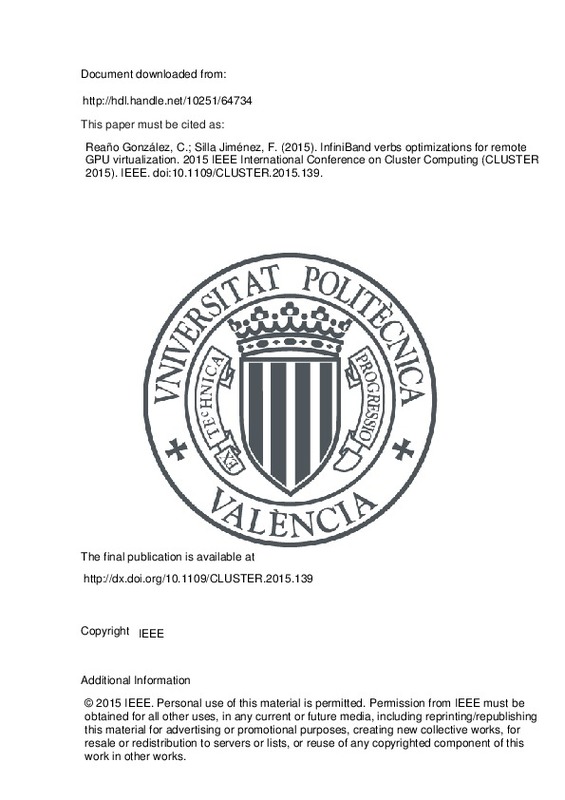JavaScript is disabled for your browser. Some features of this site may not work without it.
Buscar en RiuNet
Listar
Mi cuenta
Estadísticas
Ayuda RiuNet
Admin. UPV
InfiniBand verbs optimizations for remote GPU virtualization
Mostrar el registro sencillo del ítem
Ficheros en el ítem
| dc.contributor.author | Reaño González, Carlos
|
es_ES |
| dc.contributor.author | Silla Jiménez, Federico
|
es_ES |
| dc.date.accessioned | 2016-05-26T07:28:38Z | |
| dc.date.available | 2016-05-26T07:28:38Z | |
| dc.date.issued | 2015-09-08 | |
| dc.identifier.isbn | 978-1-4673-6598-7 | |
| dc.identifier.issn | 1552-5244 | |
| dc.identifier.uri | http://hdl.handle.net/10251/64734 | |
| dc.description | © 2015 IEEE. Personal use of this material is permitted. Permission from IEEE must be obtained for all other uses, in any current or future media, including reprinting/republishing this material for advertising or promotional purposes, creating new collective works, for resale or redistribution to servers or lists, or reuse of any copyrighted component of this work in other works. | es_ES |
| dc.description.abstract | The use of InfiniBand networks to interconnect high performance computing clusters has considerably increased during the last years. So much so that the majority of the supercomputers included in the TOP500 list either use Ethernet or InfiniBand interconnects. Regarding the latter, due to the complexity of the InfiniBand programming API (i.e., InfiniBand Verbs) and the lack of documentation, there are not enough recent available studies explaining how to optimize applications to get the maximum performance from this fabric. In this paper we expose two different optimizations to be used when developing applications using InfiniBand Verbs, each providing an average bandwidth improvement of 3.68% and 217.14%, respectively. In addition, we show that when combining both optimizations, the average bandwidth gain is 43.29%. This bandwidth increment is key for remote GPU virtualization frameworks. Actually, this noticeable gain translates into a reduction of up to 35% in execution time of applications using remote GPU virtualization frameworks. | es_ES |
| dc.description.sponsorship | This work was funded by the Generalitat Valenciana under Grant PROMETEOII/2013/009 of the PROMETEO program phase II. Authors are also grateful for the generous support provided by Mellanox Technologies | |
| dc.format.extent | 8 | es_ES |
| dc.language | Inglés | es_ES |
| dc.publisher | IEEE | es_ES |
| dc.rights | Reserva de todos los derechos | es_ES |
| dc.subject | InfiniBand | es_ES |
| dc.subject | CUDA | es_ES |
| dc.subject | Remote GPU virtualization | es_ES |
| dc.subject | rCUDA | es_ES |
| dc.subject | Performance | es_ES |
| dc.subject | Optimization | es_ES |
| dc.subject.classification | ARQUITECTURA Y TECNOLOGIA DE COMPUTADORES | es_ES |
| dc.title | InfiniBand verbs optimizations for remote GPU virtualization | es_ES |
| dc.type | Comunicación en congreso | es_ES |
| dc.identifier.doi | 10.1109/CLUSTER.2015.139 | |
| dc.relation.projectID | info:eu-repo/grantAgreement/GVA//PROMETEOII%2F2013%2F009/ES/DESARROLLO DE LIBRERIAS PARA GESTIONAR EL ACCESO A DISPOSITIVOS REMOTOS COMPARTIDOS EN SERVIDORES DE ALTAS PRESTACIONES/ | es_ES |
| dc.rights.accessRights | Abierto | es_ES |
| dc.contributor.affiliation | Universitat Politècnica de València. Departamento de Informática de Sistemas y Computadores - Departament d'Informàtica de Sistemes i Computadors | es_ES |
| dc.contributor.affiliation | Universitat Politècnica de València. Grupo de Arquitecturas Paralelas | es_ES |
| dc.description.bibliographicCitation | Reaño González, C.; Silla Jiménez, F. (2015). InfiniBand verbs optimizations for remote GPU virtualization. IEEE. https://doi.org/10.1109/CLUSTER.2015.139 | es_ES |
| dc.description.accrualMethod | S | es_ES |
| dc.relation.conferencename | 2015 IEEE International Conference on Cluster Computing (CLUSTER 2015) | es_ES |
| dc.relation.conferencedate | September 8-11, 2015 | es_ES |
| dc.relation.conferenceplace | Chicago, IL, USA | es_ES |
| dc.relation.publisherversion | http://dx.doi.org/10.1109/CLUSTER.2015.139 | es_ES |
| dc.type.version | info:eu-repo/semantics/publishedVersion | es_ES |
| dc.relation.senia | 294826 | es_ES |
| dc.contributor.funder | Generalitat Valenciana | |
| dc.contributor.funder | Mellanox Technologies Ltd. | es_ES |







![[Cerrado]](/themes/UPV/images/candado.png)

